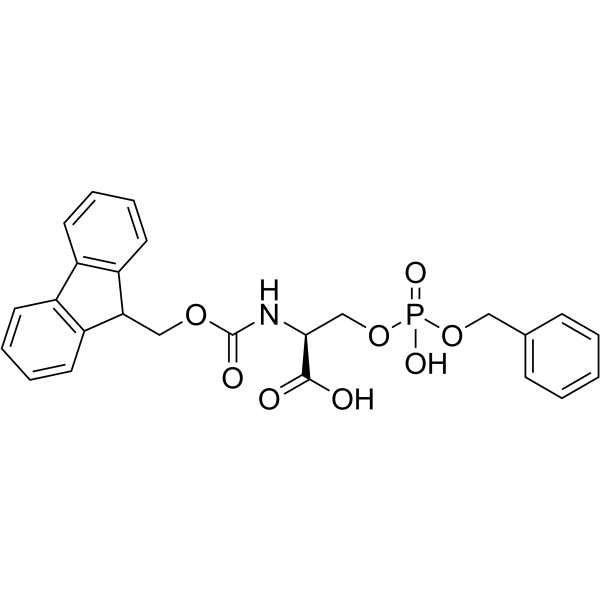O-Phospho-L-serine

O-Phospho-L-serine structure
|
Common Name | O-Phospho-L-serine | ||
|---|---|---|---|---|
| CAS Number | 407-41-0 | Molecular Weight | 185.072 | |
| Density | 1.8±0.1 g/cm3 | Boiling Point | 475.4±55.0 °C at 760 mmHg | |
| Molecular Formula | C3H8NO6P | Melting Point | 190 °C(lit.) | |
| MSDS | Chinese USA | Flash Point | 241.3±31.5 °C | |
Use of O-Phospho-L-serineO-Phospho-L-serine is the immediate precursor to L-serine in the serine synthesis pathway, and an agonist at the group III mGluR receptors (mGluR4, mGluR6, mGluR7, and mGluR8); O-Phospho-L-serine also acts as a weak antagonist for mGluR1 and a potent antagonist for mGluR2. |
| Name | O-phospho-L-serine |
|---|---|
| Synonym | More Synonyms |
| Description | O-Phospho-L-serine is the immediate precursor to L-serine in the serine synthesis pathway, and an agonist at the group III mGluR receptors (mGluR4, mGluR6, mGluR7, and mGluR8); O-Phospho-L-serine also acts as a weak antagonist for mGluR1 and a potent antagonist for mGluR2. |
|---|---|
| Related Catalog | |
| Target |
Human Endogenous Metabolite |
| In Vitro | O-Phospho-L-serine (l-SOP) weakly binds to mGluR1, and antagonizes the effects of l-glutamate. l-SOP activates the group III receptors (mGluR4, mGluR6, mGluR7, and mGluR8), but mGluR7 has much lower affinity for l-SOP than the other group III receptors and also displays lower efficacy for both ligands[1]. O-Phospho-L-serine (l-SOP) generates enhanced intracellular calcium responses in mGluR4 transfected cells. l-SOP inhibits the l-glutamate mediated mGluR1 response, with a Ki of 1 mM; l-SOP displays a substantially more potent inhibition of mGluR2 activation, with a Ki of 1 μM, three orders-of-magnitude more potent than for mGluR1. l-SOP induces membrane potential changes in HEK/TRPC4 cells transfected with mGluR4 or mGluR6. l-SOP induces TRPC4β activation mediated by Gαi/o proteins[2]. O-Phospho-L-serine (L-SOP) inhibits Müller glia proliferation, without affecting light-induced photoreceptor cell death. L-SOP disrupts Müller glia proliferation subsequent to or in parallel with the activation of ascl1a and stat3 expression in the light-damaged retina. L-SOP inhibits cone cell regeneration in the light-damaged retina[3]. |
| References |
| Density | 1.8±0.1 g/cm3 |
|---|---|
| Boiling Point | 475.4±55.0 °C at 760 mmHg |
| Melting Point | 190 °C(lit.) |
| Molecular Formula | C3H8NO6P |
| Molecular Weight | 185.072 |
| Flash Point | 241.3±31.5 °C |
| Exact Mass | 185.008926 |
| PSA | 139.89000 |
| LogP | -1.86 |
| Vapour Pressure | 0.0±2.6 mmHg at 25°C |
| Index of Refraction | 1.552 |
| Storage condition | Store at 0°C |
| Water Solubility | H2O: 50 mg/mL hot, clear, colorless to slightly yellow |
|
~60% 
O-Phospho-L-serine CAS#:407-41-0 |
| Literature: US2013/29920 A1, ; Paragraph 0700 ; |
|
~87% 
O-Phospho-L-serine CAS#:407-41-0 |
| Literature: Journal of the American Chemical Society, , vol. 110, p. 2237 |
|
~% 
O-Phospho-L-serine CAS#:407-41-0 |
| Literature: Bioorganic Chemistry, , vol. 38, # 2 p. 74 - 80 |
|
~% 
O-Phospho-L-serine CAS#:407-41-0 |
| Literature: Journal of Biological Chemistry, , vol. 106, p. 595,599 |
|
~% 
O-Phospho-L-serine CAS#:407-41-0 |
| Literature: Journal of Biochemistry (Tokyo, Japan), , vol. 29, p. 292,299 |
|
~% 
O-Phospho-L-serine CAS#:407-41-0
Detail
|
| Literature: Advanced Synthesis and Catalysis, , vol. 349, # 8-9 p. 1349 - 1352 |
|
~% 
O-Phospho-L-serine CAS#:407-41-0 |
| Literature: Acta Chemica Scandinavica (1947-1973), , vol. 11, p. 1232,1235 |
| HS Code | 2931900090 |
|---|---|
| Summary | 2931900090. other organo-inorganic compounds. VAT:17.0%. Tax rebate rate:13.0%. Supervision conditions:AB(certificate of inspection for goods inward,certificate of inspection for goods outward). MFN tariff:6.5%. General tariff:30.0% |
|
CDK5 is a major regulator of the tumor suppressor DLC1.
J. Cell Biol. 207(5) , 627-42, (2014) DLC1 is a tumor suppressor protein whose full activity depends on its presence at focal adhesions, its Rho-GTPase activating protein (Rho-GAP) function, and its ability to bind several ligands, includ... |
|
|
ATG16L1 phosphorylation is oppositely regulated by CSNK2/casein kinase 2 and PPP1/protein phosphatase 1 which determines the fate of cardiomyocytes during hypoxia/reoxygenation.
Autophagy 11 , 1308-25, (2015) Recent studies have shown that the phosphorylation and dephosphorylation of ULK1 and ATG13 are related to autophagy activity. Although ATG16L1 is absolutely required for autophagy induction by affecti... |
|
|
Enhancement of innate immune system in monocot rice by transferring the dicotyledonous elongation factor Tu receptor EFR.
J. Integr. Plant Biol. 57 , 641-52, (2015) The elongation factor Tu (EF-Tu) receptor (EFR) in cruciferous plants specifically recognizes the N-terminal acetylated elf18 region of bacterial EF-Tu and thereby activates plant immunity. It has bee... |
| dexfosfoserine |
| O-Phospho-L-serine |
| 3-O-(phospho)-L-serine |
| P-serine |
| L-O-phosphoserinate |
| DL-SERINE PHOSPHATE HYDRATE |
| O-Phosphoserine |
| O-phosphoryl-L-serine |
| L-(+)-phosphoserine |
| O-Phosphono-L-serine |
| Seriphos |
| P-ser |
| L-serine-O-phosphate |
| 3-P-SERINE |
| L-O-(RG) |
| L-Serine Phosphate |
| L-O-serine phosphate |
| L-Serine, O-phosphono- |
| L-O-Phosphoserine |
| EINECS 206-986-0 |
| L-SOP |
| H-SER(P)-OH |
| Fosforina |
| MFCD00065935 |
| Phosphoserine |








